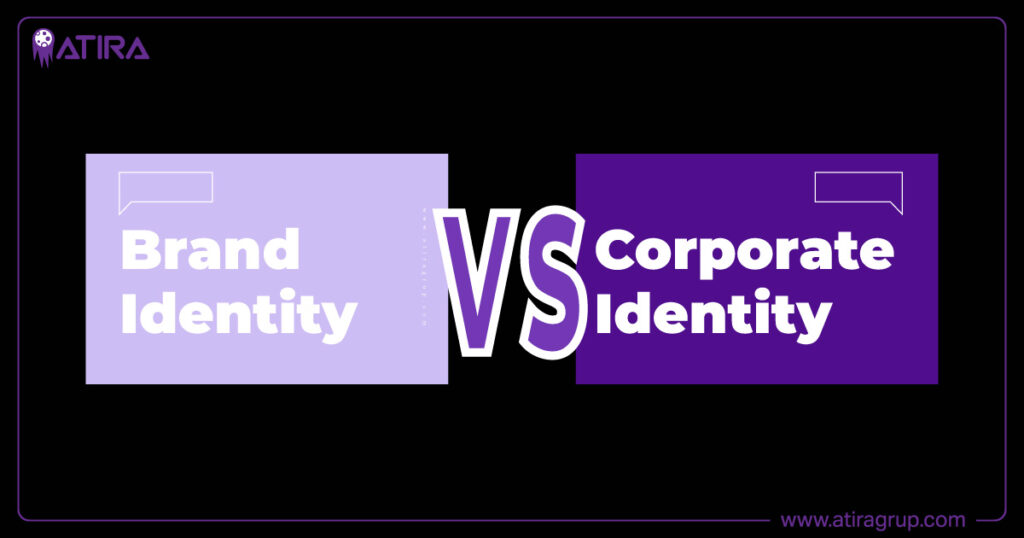Corporate identity is how a company presents itself through its values, culture, and visuals. It’s essential for distinguishing your business and earning customer trust.
Table of Contents
This article will explore the key elements of corporate identity and why they matter for your company’s success.
Key Takeaways
- Corporate identity encompasses visual elements, internal culture, and communication, shaping how a company is perceived by stakeholders and enhancing customer trust and loyalty.
- A consistent corporate identity is vital for distinguishing a company in the market and fostering emotional connections, with key components including corporate communications, visual identity, and corporate behavior.
- Successful corporate identities, exemplified by brands like Apple and Starbucks, illustrate the importance of maintaining alignment with core values and actively engaging with audiences, particularly through social media.
Understanding Corporate Identity
Corporate identity is the backbone of any company’s public image. It goes beyond mere logos and color schemes; it encompasses the company’s values, culture, and the way it communicates with both internal and external audiences.

A well-defined corporate identity helps a company stand out in the market, fostering customer trust and loyalty.
So, what does corporate identity include, and why is it significant?
Definition of Corporate Identity
Corporate identity is a multifaceted concept that defines how an organization presents itself through its actions, behavior, and public perception. It includes not only the visual elements like logos and color schemes but also the company’s behaviors, ethics, and values.
One common misconception is that corporate identity is limited to logos and branding; in reality, it encompasses much more, including the internal culture and values that shape how the company is perceived both internally and externally.
A strong corporate identity speaks volumes about a company’s philosophy and core values, helping to create a consistent corporate identity that resonates with stakeholders and the public alike.
Understanding that brand identity is a subset of corporate identity helps in recognizing that it reflects the company itself through its products and services.
Importance of Corporate Identity
Several reasons underscore the importance of a strong corporate identity. Firstly, it helps the target audience identify and relate to the corporation, creating a lasting impression on stakeholders.
By being clear and consistent, corporate identity distinguishes a company from its competitors, enhancing recognition and memorability. A positive corporate identity often results in higher sales, customer loyalty, and favorable recommendations.
Statistics show that 68% of consumers track their purchases and are willing to spend more on trusted corporations, highlighting the financial impact of a strong corporate identity.
This trust and loyalty are built through cohesive corporate identity standards, which ensure clarity in communications and foster emotional connections with customers.
On the flip side, inconsistent corporate identity can lead to customer confusion and a negative reputation for the company. Therefore, maintaining a consistent corporate identity is not just beneficial but essential for any business aiming to build a strong identity and achieve long-term success.
Core Components of Corporate Identity
Corporate identity is built on three core components: corporate communications, visual identity, and corporate behavior. Each of these elements plays a crucial role in shaping how a company is perceived by its stakeholders and the general public.

Effectively managing these components helps a business create a consistent and recognizable brand, bolstering its overall corporate image.
Corporate Communications
Corporate communications are the lifeline of any organization, playing a crucial role in influencing perceptions through consistent messaging to both internal and external audiences. The primary goal of corporate communication is to build and maintain a strong company identity, ensuring that all stakeholders, from employees to customers, understand and resonate with the company’s values and mission.
Timely responses to customer queries on social media can significantly enhance brand reputation, while storytelling can create deeper emotional connections with customers.
Consistent messaging shapes perceptions among both internal and external audiences. Whether it’s through press releases, social media updates, or internal memos, maintaining a unified voice and tone helps reinforce the company’s identity and build trust. Corporate communication strategies should create awareness and foster customer trust and loyalty.
Visual Identity
Visual identity is a vital component of corporate identity, as it creates a cohesive and recognizable brand that resonates with customers. Key elements of visual identity include logos, color schemes, and typography, all of which shape customers’ perceptions of the brand. These elements, when used consistently across all marketing collateral, ensure that the brand is easily recognizable and trustworthy.
Maintaining consistency requires effective visual identity guidelines. These guidelines detail approved logo designs, color palettes, and typography for brand representation, ensuring that all visual elements align with the company’s core values and overall corporate identity.
A unified approach to brand design across all materials enhances customer recognition and contributes to building a strong corporate identity.
Corporate Behavior
Corporate behavior reflects the organization’s internal values and ethics, influencing how it interacts with stakeholders and the broader community. This behavior is dictated by a combination of company policies, ethical standards, and responses to external factors. For instance, Starbucks is renowned for creating a welcoming environment that enhances customer experience and loyalty. The brand’s identity is deeply linked to its social responsibility initiatives, including support for local communities.
Various factors, such as political, economic, social, technological, legal, and environmental considerations, influence corporate behavior. Ethical considerations specific to each company’s operating environment also play a significant role. Aligning corporate behavior with core values and philosophy builds a strong identity and fosters long-term customer loyalty.
Corporate Identity vs Brand Identity
Distinguishing between corporate identity and brand identity is essential for understanding how these concepts contribute to a company’s overall image. While corporate identity encompasses the entire company’s characteristics, including communication, behavior, and design, brand identity focuses on the visual and emotional representation of individual products.

Recognizing this distinction aids in crafting strategies that enhance both the corporate brand and its products and services.
Corporate Identity Explained
Corporate identity encompasses the entire company’s characteristics, distinguishing it from branding, which focuses on specific products. It includes:
- The company’s visual representation
- Organizational culture
- Public perception
- Internal alignment
Corporate identity deals with the overall representation of an organization, while brand image is more concerned with consumer perceptions. The corporate image refers to the current external perception and overall associations held by consumers regarding a company.
Corporate culture is intrinsically linked to branding and serves as a foundation for how a company presents itself to the market. Fostering a strong corporate culture ensures that corporate identity speaks consistently and authentically, building trust and loyalty.
Brand Identity Explained
Brand identity refers to the perception by the target audience. It focuses on the specific attributes and perception of individual products, crafting a visual and emotional representation that resonates with consumers. While corporate identity embodies the essence of a company, brand identity zeroes in on highlighting the unique aspects of its products and services.
This distinction is crucial for effective brand marketing and management strategies.
The Role of Corporate Design in Corporate Identity
Corporate design plays a pivotal role in shaping corporate identity design. It serves as the visual representation of a company’s corporate brand identity, encompassing aspects such as logos, color palettes, and typography. These visual elements not only create a cohesive brand image but also differentiate a company from its competitors, enhancing its overall corporate visual identity.

Key Elements of Corporate Design
Key visual identifiers in corporate design include logos, colors, and typography. Effective corporate design emphasizes the use of these visual identifiers to ensure brand recognition. Guidelines for visual elements should encompass logo usage, color codes, and typography rules to maintain consistency.
Companies like NatWest and Spotify demonstrate the importance of refreshing corporate visual identities to reflect broader service offerings. Airbnb’s significant rebrand introduced a versatile color palette and recognizable icons, accommodating evolving market needs.
Spotify’s ongoing updates in corporate design illustrate that strong brands adapt their visual identities to resonate with current trends. Incorporating these key elements helps companies build a durable corporate identity.
Consistent Brand Design
Maintaining a consistent brand design across all marketing collateral is essential to build a strong corporate identity and ensure brand recognition. Visual identity markers should be strategic and agile to keep the business relevant, adapting to changing market trends and consumer preferences. A consistent brand design not only builds customer loyalty but also reinforces the company’s core values and philosophy.
Aligning all visual elements with the brand’s identity creates a consistent atmosphere, enhancing customer trust and loyalty. This consistency extends to product packaging, marketing materials, and even staff uniforms, creating a unified brand presence that resonates with customers.
Building a Strong Corporate Identity
Building a strong corporate identity involves several key steps, including conducting a brand audit, developing visual elements, and establishing comprehensive brand guidelines. These steps help ensure that the company’s identity aligns with its core values and resonates with its target audience.

Following these steps helps businesses create a consistent and recognizable brand presence, fostering customer trust and loyalty.
Conducting a Brand Audit
The purpose of conducting a brand audit is to review and evaluate the current corporate identity, identifying inconsistencies and areas needing enhancement. A brand audit helps refine and strengthen the corporate identity by gathering feedback from employees and stakeholders, ensuring a comprehensive evaluation. Effective corporate communications contribute to establishing a strong value proposition that resonates with both internal and external audiences.
Conducting a thorough brand audit helps companies identify gaps and opportunities for improvement, keeping their corporate identity relevant and aligned with core values. This process is essential for maintaining a strong and consistent corporate identity.
Developing Visual Elements
Visual elements play a crucial role in establishing a company’s identity and should encapsulate the brand’s personality. These elements, including logos, color schemes, and typography, should resonate with the target audience’s preferences. Incorporating local cultural elements into branding can enhance relatability and acceptance among target demographics. Collaborating with designers can help create the best visual representation of the brand assets, ensuring consistency and alignment with core values.
Developing visual elements that reflect core values and appeal to the audience helps businesses build a strong and recognizable corporate identity. These visual identifiers not only enhance brand recognition but also build customer trust and loyalty.
Establishing Brand Guidelines
Comprehensive brand guidelines are essential to ensure uniformity in corporate communications. These guidelines typically include the corporate title, logo, approved color palettes, typefaces, page layouts, and fonts, ensuring that all visual and messaging elements align with the company’s values and overall identity. Effective corporate communications ensure that messaging aligns with the company’s values, contributing to a unified brand image.
Establishing and adhering to brand guidelines ensures a consistent corporate identity across all platforms and materials. This consistency helps build a strong brand that resonates with customers and fosters long-term loyalty.
Examples of Successful Corporate Identities
Examining successful corporate identities provides valuable insights into best practices and strategies. Companies like Apple and Starbucks have mastered their corporate identities, creating strong, recognizable brands that resonate with customers worldwide.

These examples underscore the importance of consistency, alignment with the company’s values, and effective communication in building a strong corporate identity.
Apple
A key element of Apple’s corporate identity is its focus on exclusivity. This aspect plays a significant role in how the brand is perceived by consumers. Apple maintains consistency in its corporate identity by keeping products within its ecosystem and sending the same corporate messages across all its offerings. This approach not only enhances brand recognition but also fosters a sense of premium quality and innovation.
Additionally, Apple engages with educational programs for suppliers, reflecting its commitment to community support and corporate social responsibility. Aligning its corporate behavior with core values has helped Apple build a strong corporate identity that resonates with customers and enhances its brand image.
Starbucks
Starbucks is renowned for its commitment to delivering high-quality coffee, consistent with its corporate promise. The company provides a consistent atmosphere in its stores, ensuring customers experience familiarity and comfort. This consistency extends to all its offerings, reinforcing the brand’s identity and fostering customer loyalty.
Starbucks actively contributes to social responsibility by providing employment opportunities for refugees, demonstrating its commitment to ethical practices and community support. Integrating social responsibility into its corporate identity has helped Starbucks build a strong and positive brand image that resonates globally.
The Impact of Social Media on Corporate Identity
Social media has a significant impact on corporate identity, shaping how brands are perceived by the public. It offers a platform for direct engagement with customers, allowing companies to build and maintain a strong corporate identity.

However, it also poses challenges, as negative feedback and brand infringement can damage a company’s reputation. Effectively leveraging social media is crucial for managing and enhancing corporate identity.
Engaging with Customers
Engaging with customers on social media requires understanding local customs and cultural nuances to effectively communicate the brand message. Adapting brand messaging to local languages and communication styles helps ensure cultural sensitivity and enhances consumer engagement. Collaborating with local influencers can strengthen a brand’s presence and credibility by creating a relatable image among the target audience.
What people say online about the business is a primary reflection of a brand’s integrity. Actively engaging with customers and addressing feedback helps companies build trust and loyalty, creating a positive brand image.
Managing Brand Image
Brands must actively monitor social media feedback to prevent negative perceptions from escalating and damaging their reputation. Monitoring online conversations is essential for understanding public sentiment and adjusting strategies accordingly. Proactive management of customer interactions on social media can prevent potential crises and protect brand image.
Regular responses to customer feedback on social media can enhance trust and brand loyalty. Effectively managing brand image on social media helps maintain a strong corporate identity and foster long-term customer relationships.
Maintaining Corporate Identity in New Markets
Entering new markets poses challenges for maintaining a consistent corporate identity. Businesses must assess local consumer behaviors and preferences to align their corporate identity with market expectations. Adapting corporate identity strategies to fit regional specifics is crucial for establishing a connection with local audiences and fostering brand loyalty.

Cultural Considerations
Cultural considerations are essential for creating a relevant and trustworthy corporate identity across diverse markets. Respecting local cultures and integrating them into corporate identity is crucial for building trust and relevance in new markets. By aligning their corporate identity with local cultural values, businesses can enhance their market presence and foster customer loyalty.
Brands must respect local cultural values to maintain relevance when introducing their corporate identity in diverse markets. This approach not only builds trust but also enhances the company’s overall brand image.
Market-Specific Strategies
When expanding into new markets, it is crucial for companies to adapt their corporate identity strategies to fit regional specifics. Tailoring corporate identity strategies allows businesses to better resonate with local customer preferences and cultural norms. Respecting and integrating local cultures into corporate identity helps maintain relevance and fosters customer loyalty.
Developing market-specific strategies aligned with regional trends and preferences enhances market presence and builds a recognizable corporate identity that resonates with local audiences.
Summary
In conclusion, mastering corporate identity is essential for any business aiming to stand out in today’s competitive market. A strong corporate identity encompasses corporate communications, visual identity, and corporate behavior, creating a consistent and recognizable brand presence.
By understanding the distinction between corporate identity and brand identity, leveraging corporate design, and following practical steps to build and maintain a strong corporate identity, businesses can foster customer trust and loyalty.
As demonstrated by successful companies like Apple and Starbucks, a well-defined corporate identity not only enhances brand recognition but also contributes to long-term success. Embrace the power of corporate identity and watch your business thrive.
Read more about Corporate Identity Design.
More about Corporate Identity
Frequently Asked Questions

What is the difference between corporate identity and brand identity?
Corporate identity refers to the overall characteristics of a company, including its communication and design, whereas brand identity is specifically centered on the visual and emotional representation of individual products. Understanding this distinction is crucial for effectively conveying a company’s values and offerings.
Why is a strong corporate identity important?
A strong corporate identity is essential as it differentiates a company from competitors and builds customer trust and loyalty. This ultimately enhances brand recognition and drives sales, establishing a solid foundation for long-term success.
What are the core components of corporate identity?
The core components of corporate identity are corporate communications, visual identity, and corporate behavior, which collectively influence stakeholder perceptions of the company. These elements are essential for establishing a strong and coherent brand presence.
How does social media impact corporate identity?
Social media profoundly impacts corporate identity by directly influencing public perception and facilitating customer engagement. While it offers opportunities for connection, it also exposes companies to risks from negative feedback and potential brand infringement.
What steps can a company take to build a strong corporate identity?
To build a strong corporate identity, a company should conduct a brand audit, develop visual elements that reflect its personality, and establish comprehensive brand guidelines for consistency across all platforms. This ensures a cohesive and recognizable presence in the market.


